David Stairs
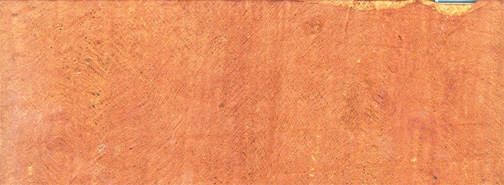
Upon meeting Kabaka Mutesa I, King of the Baganda, in 1878, Henry Morton Stanley was favorably impressed. In Through the Dark Continent, among the many journal observations regarding his visit to the shores of Lake Victoria, he had this to say about Bagandan dress:
The women and chiefs of Mutesa, who may furnish the best specimens of Waganda, are nearly all of a bronze or dark reddish brown, with peculiar smooth, soft skins… The native cloths—the national dress—which depended from the right shoulders of the larger number of those not immediately connected with the court were of a light brown also. It struck me, when I saw the brown skins, brown robes, and brown canoes, that brown must be the national color.1
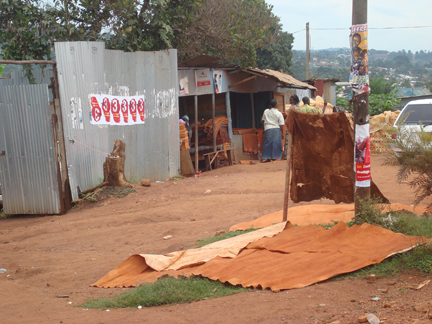
Barkcloth merchants on Masaka Road in Nateete, Uganda
This passage aptly describes the traditional Bagandan material known as lubuggo or “barkcloth,” fabric made from fig tree bark. At the time of the historic meeting between Mutesa and Stanley, barkcloth was widely used by the Baganda. The Baganda had many grades of barkcloth, from that considered fit for the Kabaka on down to very rough material used by the poor. A softer version was employed for bed sheets, with a stiffer version for blankets. One advantage of barkcloth over cotton, it seems, is that mosquitoes can’t bite through it.
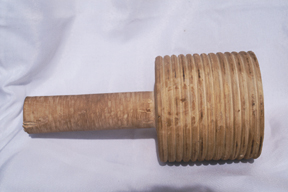 Barkcloth mallet or ensaka
Barkcloth mallet or ensaka
Fabric made from bark is not unique to Uganda. The practice also exists in West Africa, specifically Ghana, and other tropical locations of Asia, Indonesia, and the Pacific where a variety of tree species are used, including mulberry. Since many modern Ugandan languages derive from a Bantu parent tongue, both language and fabric could be connected to the great Bantu diaspora east and south that occurred there about 2,000 years ago.
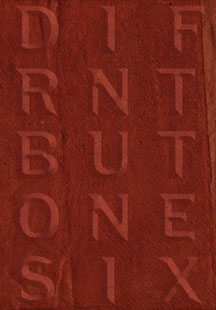 Exhibition catalogue cover
Exhibition catalogue cover
Strips of bark about ten inches wide and two yards long are cut from the tree, then laid across a log beam and beaten into spreads with a series of ensakas or wooden mallets. Beginning with a coarse, or wide-toothed mallet, and proceeding toward progressively smaller-toothed tools, the bark is pounded thin, spreading it out to a width of several feet. Where it becomes too thin it is patched. Through this painstaking process pieces several meters long and wide can be produced. And by careful “bandaging” of the tree it can continue to provide bark for many years.
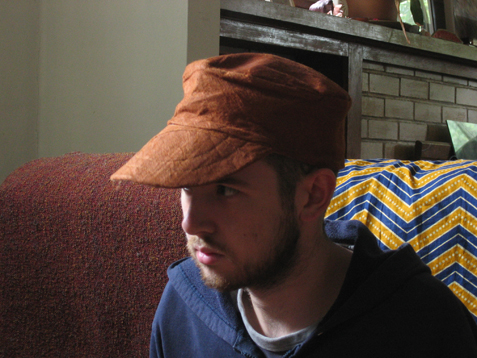
Barkcloth can be coaxed into a variety of clothing forms such as hats, as well as tourist items like photo album covers. After the arrival of European missionaries Ugandans converted to cotton garments and the technique for making lubuggo almost became a lost art. Today Ugandans themselves use barkcloth primarily for ceremonial purposes (although in rural areas, it is still used for bed sheets by children and the elderly) from funerals, where a village elder might be wrapped in several dozen layers, to weddings, and engagement ceremonies. Fortunately, there is also a secondary demand for it among artists. Ugandans paint on lubuggo, or stitch it onto their canvases. They also print patterns on it as it makes a suitable substrate for serigraphy.
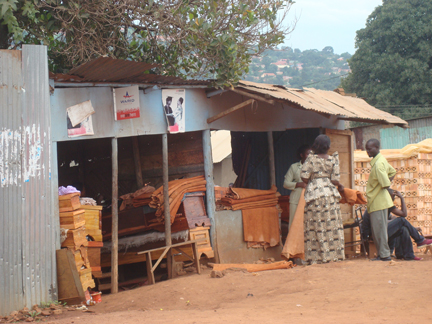
Not to be confused with the retro-chic vintage cotton fabric flooding e-bay and other e-commerce sites, Ugandan barkcloth is the real deal: fragrant, scratchy, and impeccably red-brown. Don’t try to buy it online though. Get yourself a plane ticket to Uganda and visit the outlet stalls on Masaka Road in Nateete where you can purchase an armful.
Notes
1 Hugon, Anne. The Exploration of Africa. London:Thames and Hudson, 1993, p. 141.
David Stairs is the founding editor of Design-Altruism-Project











Leave a Reply
You must be logged in to post a comment.